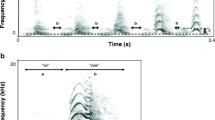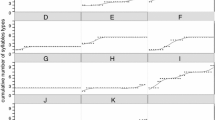Abstract
In some primate species, males and females within a social group emit loud calls in a coordinated manner or chorus. Indri indri emits a very conspicuous loud call that elicits the loud calls of neighboring groups. Previous investigations have hypothesized that the main functions of the indri chorus are related to territorial announcement, intergroup avoidance, and group cohesion. We investigated sex differences in indri song. We recorded and analysed songs given by 10 different groups over 160 d. Overall singing duration did not vary between the sexes. However, males emitted significantly fewer but longer notes. Adult males and females of each group participated in the song with sex-specific repertoires. Females had a song repertoire of 8 note types; males shared all of their 6 notes with females. Apart from the initial roars, in all note types shared by both sexes, male notes were significantly longer than female ones, whereas variations in frequency parameters differed according to the note type. These findings suggest that indri song may provide cues to conspecifics, such as group size and sex composition, which could influence interactions between groups.


Similar content being viewed by others
References
Benz, J. J., French, J. A., & Leger, D. W. (1990). Sex differences in vocal structure in a callitrichid primate, Leontopithecus rosalia. American Journal of Primatology, 21, 257–264.
Boehm, C. (1999). Hierarchy in the forest: the evolution of egalitarian behavior. Cambridge: Harvard University Press.
Boersma, P., & Weenink, D. (2008). Praat: Doing phonetics by computer (computer program). Retrieved from http://www.praat.org.
Cournac, L., Dubois, M. A., & Riera, B. (2003). Rapid methods for characterizing forest structure in Madagascar. In S. M. Goodman & J. P. Benstead (Eds.), The natural history of Madagascar (pp. 96–103). Chicago: University of Chicago Press.
Darwin, C. (1871). The descent of man and selection in relation to sex. London: John Murray.
Deputte, B. L. (1973). Étude d’un type de comportement vocal chez un groupe cap-tif de mangabeys (Cercocebus albigena). In Méthode télémetrique d’enregistrement individuel des vocalisations. D.E.A. Biologie Animale, Eco-Ethologie, Université de Rennes I.
Deputte, B. L. (1982). Duetting in male and female songs of the white-cheeked gibbon (Hylobates concolor leucogenys). In C. T. Snowdon, C. H. Brown, & M. R. Petersen (Eds.), Primate communication (pp. 67–93). Cambridge: Cambridge UniversityPress.
De Vore, I., & Hall, K. R. L. (1965). Baboon ecology. In I. de Vore (Ed.), Primate behaviour: Field studies of monkeys and apes. New York: Holt, Reinhart and Winston.
Dixson, A. F. (1998). Primate sexuality. New York: Oxford University Press.
Ey, E., Hammerschmidt, K., Seyfarth, R. M., & Fischer, J. (2007a). Age- and sex-related variations in clear calls of Papio ursinus. International Journal of Primatology, 28, 947–960.
Ey, E., Pfefferle, D., & Fischer, J. (2007b). Do age- and sex-related variations reliably reflect body size in non-human primate vocalizations? A review. Primates, 48, 253–267.
Favaro, L., Gamba, M., Sorrentino, V., Torti, V., & Giacoma, C. (2008). Singers in the forest: Acoustic structure of indri’s loud calls and first evidence of vocal tract tuning in a prosimian primate. 35° convegno nazionale dell’Associazione Italiana di Acustica 2008.
Fischer, J., & Hammerschmidt, K. (2002). An overview of the Barbary macaque, Macaca sylvanus, vocal repertoire. Folia Primatologica, 73, 32–45.
Fitch, W. T. (1997). Vocal tract length and formant frequency dispersion correlate with body size in rhesus macaques. Journal of the Acoustical Society of America, 102, 1213–1222.
Fitch, W. T. (2000). The phonetic potential of nonhuman vocal tracts: Comparative cineradiographic observations of vocalizing animals. Phonetica, 57(2–4), 205–218.
Fitch, W. T., & Hauser, M. D. (1995). Vocal production in nonhuman primates: acoustics, physiology and functional constraints on ‘honest’ advertising. American Journal of Primatology, 37, 191–219.
Gamba, M., & Giacoma, C. (2007). Quantitative acoustic analysis of the vocal repertoire of the crowned lemur. Ethology Ecology & Evolution, 19, 323–343.
Garbutt, N. (1999). Mammals of Madagascar. New Haven and London: Yale UniversityPress.
Geissmann, T. (1993). Evolution of communication in gibbons (Hylobatidae). Ph.D. thesis, Anthropological Institute, Philosophical Faculty II, Zürich University. (English text, German summary).
Geissmann, T. (2002). Duet-splitting and the evolution of gibbon songs. Biological Reviews, 77, 57–76.
Geissmann, T., & Mütschler, T. (2006). Diurnal distribution of loud calls in sympatric wild indri (Indri indri) and ruffed lemurs (Varecia variegata): implications for call functions. Primates, 47, 393–396.
Geissmann, T., & Nijman, V. (2006). Calling in wild silvery gibbons (Hylobates moloch) in Java (Indonesia): behavior, phylogeny and conservation. American Journal of Primatology, 68, 1–19.
Ghazanfar, D., Smith-Rohrberg, D., Pollen, A., & Hauser, M. D. (2002). Temporal cues in the antiphonal calling behaviour of cotton-top tamarins. Animal Behaviour, 64, 427–438.
Green, S. M. (1981). Sex differences and age gradations in vocalizations of Japanese and lion-tailed monkeys (Macaca fuscata and Macaca silenus). American Zoologist, 21(1), 165–183.
Hauser, M. D. (1993). The evolution of nonhuman primate vocalizations: Effects of phylogeny, body weight and social context. American Naturalist, 142, 528–542.
Hewitt, G., MacLarnon, A., & Jones, K. E. (2002). The function of laryngeal air sac in Primates: a new hypothesis. Folia Primatologica, 73(2–3), 70–94.
Heymann, E. W. (1987). Behavior and communication of moustached tamarins Saguinus mystax mystax (Primates: Callitrichidae), in an outdoor enclosure. I. The physical structure of long calls of the moustached tamarin. Primate Report, 17, 45–52.
Koffi Bene, J. C., & Zuberbüler, K. (2009). Sex differences in the use of vocalizations in wild olive Colobus monkeys. European Journal of Scientific Research, 25(2), 267–280.
Konrad, R., & Geissmann, T. (2006). Vocal diversity and taxonomy of Nomascus in Cambodia. International Journal of Primatology, 27(3), 713–743.
Locke, J. L., & Hauser, M. D. (1999). Sex and status effects on primate volubility: clues to the origin of vocal languages? Evolution and Human Behaviour, 20, 151–158.
Marler, P., & Tenaza, R. (1977). Signaling behavior of apes with special reference to vocalization. In T. A. Sebeok (Ed.), How animals communicate (pp. 965–1033). Bloomington: Indiana University Press.
Marshall, J. T., Ross, B. A., & Chantharojvong, S. (1972). The species of gibbons in Thailand. Journal of Mammalogy, 53, 479–486.
Masataka, N. (1987). The perception of sex-specificity in long calls of the tamarin (Saguinus labiatus). Ethology, 76, 56–64.
Mendez-Cardenas, M., Randriananbinina, B., Rabesandratana, A., Rasoloharijaona, S., & Zimmermann, E. (2008). Geographic variation in loud calls of sportive lemurs (Lepilemur spp.) and their implications for conservation. American Journal of Primatology, 70, 1–11.
Milne-Edwards, H., & Grandidier, A. (1875). Histoire physique, naturelle, et politique de Madagascar. Paris: Imprimerie nationale.
Mitani, J. C., & Stuht, J. (1998). The evolution of nonhuman primate loud calls: acoustic adaptation for long-distance propagation. Primates, 39, 171–182.
Mittermeier, R. A., Konstant, W. R., Hawkins, F., Louis, E. E., Langrand, O., Ratsimbazafy, J., et al. (2006). Lemurs of Madagascar (2nd ed.). Washington: Conservation International.
Müller, A. E., & Anzenberger, G. (2002). Duetting in the Titi monkey Callicebus cupreus: Structure, pair specificity and development of duets. Folia Primatologica, 73(2–3), 104–115.
Norcross, J. L., & Newman, J. D. (1993). Context and sex-specific differences in the acoustic structure of common marmoset phee calls (Callithrix jacchus). American Journal of Primatology, 30, 37–54.
Norcross, J. L., Newman, J. D., & Cofrancesco, L. M. (1999). Context and sex differences exist in the acoustic structure of phee calls by newly paired common marmosets (Callithrix jacchus). American Journal of Primatology, 49, 165–181.
Patel, E. R., & Owren, M. J. (2007). Acoustics and behavioral contexts of “gecker” vocalizations in young rhesus macaques (Macaca mullata). Journal of the Acoustic Society of America, 121, 575–585.
Petter, J. J. (1962). Recherches sur l’ecologie et l’ethologie des lemuriens malagache. Memoires de Museum National d’Histoire Natural (Paris), 27, 1–46.
Petter, J. J., Albignac, R., & Rumpler, Y. (1977). Mammifères lémuriens. In Faune de Madagascar, 44 (pp. 391–410).
Petter, J. J., & Charles-Dominique, P. (1979). Vocal communication in prosimians. In G. A. Doyle & R. D. Martin (Eds.), The study of prosimian behaviour (pp. 272–282). New York: Academic Press.
Plichta, B. (2005). Akustyk (Computer Program). Retrieved from http://www.msu.edu/plichtab.
Pollock, J. I. (1986). The song of the indris (Indri indri; Primates: Lemuroidea): Natural history, form and function. International Journal of Primatology, 7(3), 225–264.
Powzyk, J. A. (1997). The socio-ecology of two sympatric indriids: Propithecus diadema diadema and Indri indri, a comparison of feeding strategies and their possible repercussions on species-specific behaviors. PhD Dissertation, Duke University, Durham, NC.
Powzyk, J., & Thalmann, U. (2003). Indri indri, Indri. In S. M. Goodman & J. P. Benstead (Eds.), The natural history of Madagascar (pp. 1342–1345). Chicago: University of Chicago Press.
Rendall, D., Owren, M. J., Weerts, E., & Hienz, R. D. (2004). Sex differences in the acoustic structure of vowel-like grunt vocalizations in baboons and their perceptual discrimination by baboon listeners. Journal of the Acoustic Society America, 115(1), 411–421.
Robinson, J. G. (1979). Vocal regulation of use of space by groups of titi monkeys Callicebus moloch. Behavioral Ecology and Sociobiology, 5(1), 1–15.
Seyfarth, R. M., Cheney, D. L., & Marler, P. (1980). Vervet monkey alarm calls: Semantic communication in a free-ranging primate. Animal Behaviour, 28, 1070–1094.
Sorrentino, V., Gamba, M., & Giacoma, C. (2008). Song stereotypy and repertoire size of the indris near Andasibe(Madagascar). In G. Cordoni, I. Norscia, & E. Palagi (Eds.), Proceedings of the XVIII Congress of the Italian Primatological Society (16-18 May, 2007). Folia Primatologica, 79, 123–159.
Sorrentino, V., Gamba, M., & Giacoma, C. (in press). A quantitative description of the vocal types emitted in the indri’s song, In J. C. Masters, M. Gamba, & F. Genin (Eds.), Leaping ahead: Advances in prosimian biology. New York: Springer.
Thalmann, U., Geissmann, T., Simona, A., & Mutschler, T. (1993). The indris of Anjanaharibe-Sud, northeastern Madagascar. International Journal of Primatology, 14, 357–381.
Waser, P. M. (1977). Individual recognition, intragroup cohesion and intergroup spacing: Evidence from sound playback to forest monkeys. Behaviour, 60, 28–74.
Acknowledgments
This research was supported by Università degli Studi di Torino and the Ministero dell’Istruzione, dell’Università e della Ricerca through the project Promozione di attività formative inerenti la Conservazione della Biodiversità presso l’Università di Mahajanga (Madagascar) and by grants from the Parco Natura Viva—Centro Tutela Specie Minacciate. We thank Association Nationale pour la Gestion des Aires Protégées Madagascar, Association Mitsinjo, Dr. Cesare Avesani Zaborra, Dr. Caterina Spiezio, Herijaona Randriamanantenasoa, Fanomezantsoa Andrianirina, Lanto, and Mamatin for their help and logistic support. The authors also thank 2 anonymous referees and the editor for their comments on early versions of this paper.
Author information
Authors and Affiliations
Corresponding author
Rights and permissions
About this article
Cite this article
Giacoma, C., Sorrentino, V., Rabarivola, C. et al. Sex Differences in the Song of Indri indri . Int J Primatol 31, 539–551 (2010). https://doi.org/10.1007/s10764-010-9412-8
Received:
Accepted:
Published:
Issue Date:
DOI: https://doi.org/10.1007/s10764-010-9412-8




